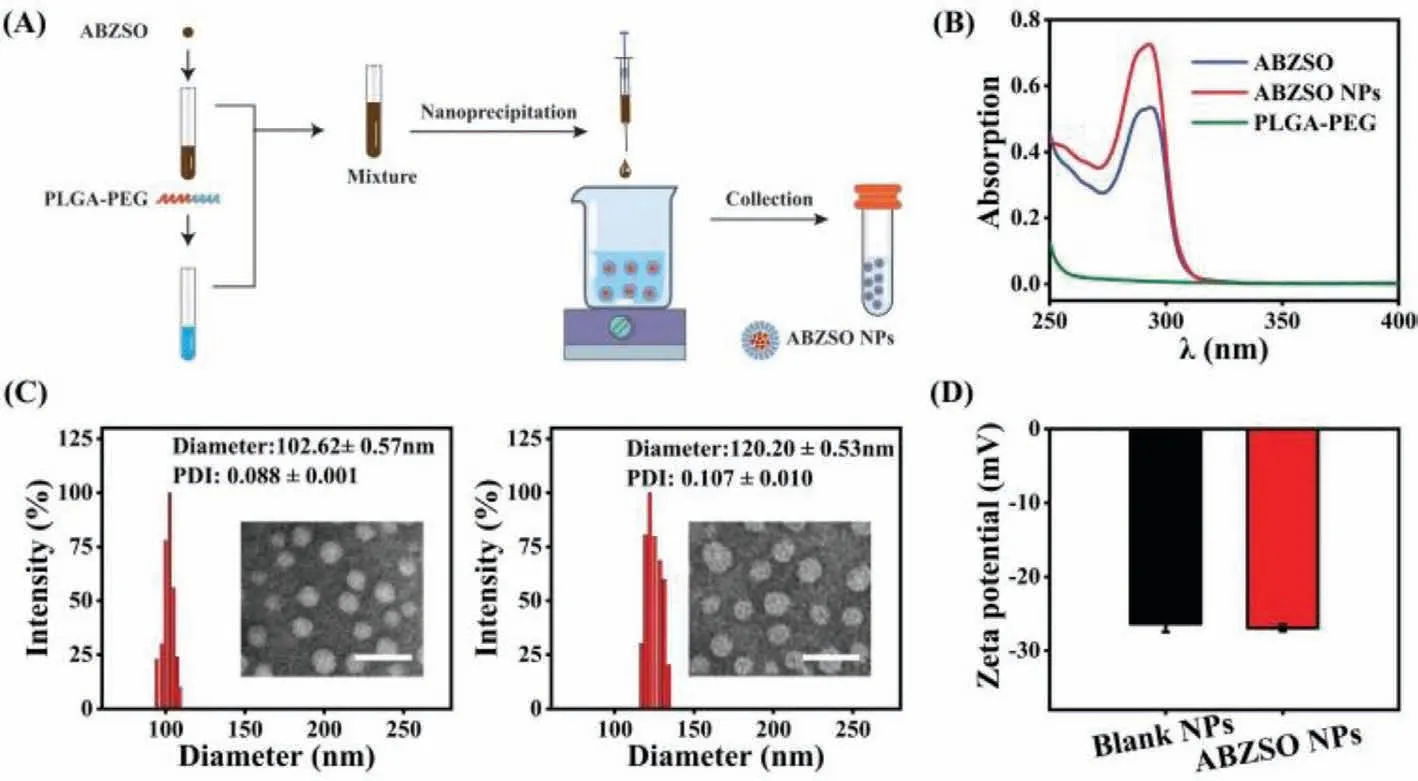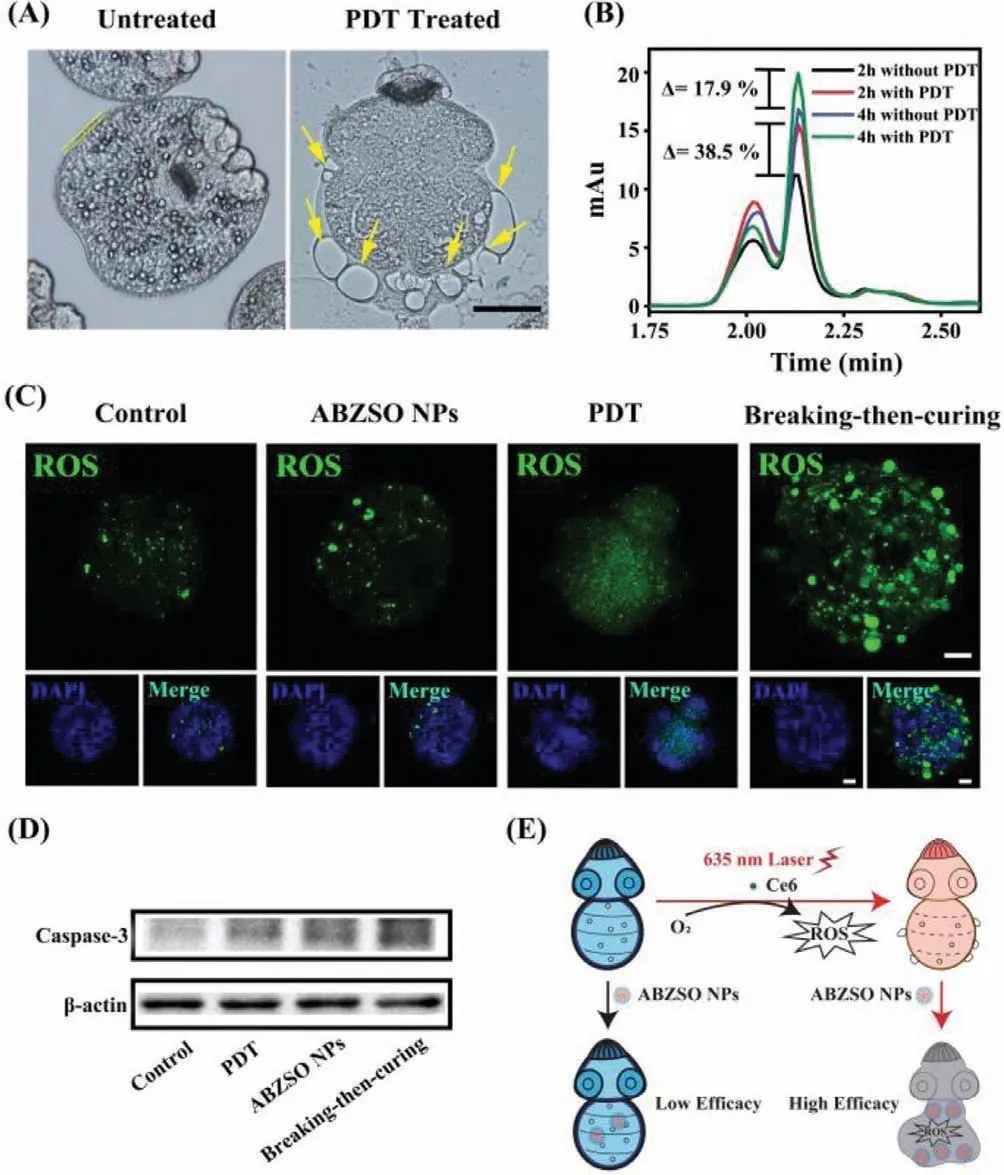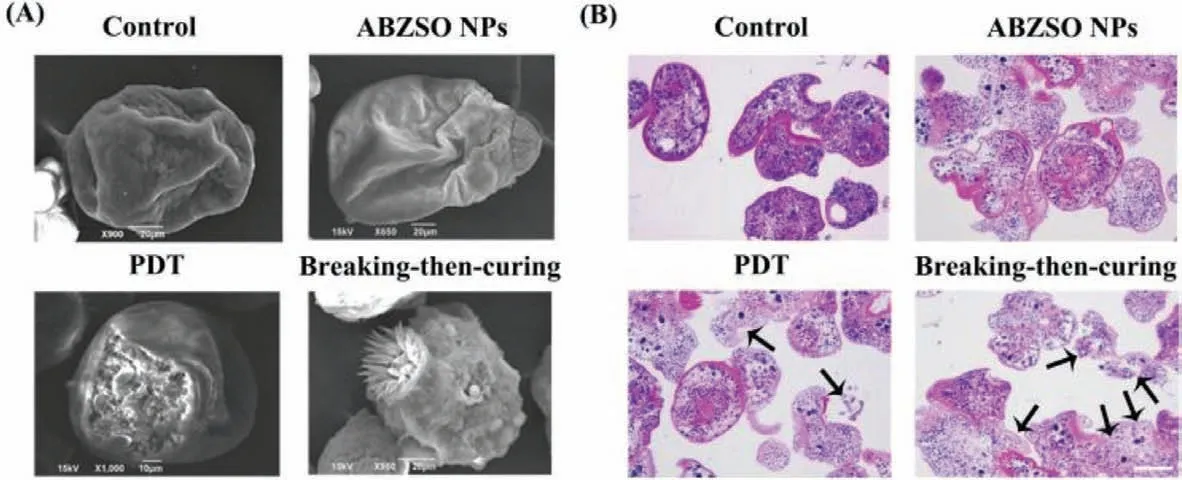Breaking-then-curing strategy for efficient cystic echinococcosis therapy
Tinjio Zhou,Yun Xu,Yuehong Gong,Mingto Yu,Enzhen Xu,Wusimnjing Aimiti,Ruiji M,Lei Xing,Ho Wen,Jinhu Wngb,,∗,Hulin Jing,,∗
a State Key Laboratory of Natural Medicines,China Pharmaceutical University,Nanjing 210009,China
b State Key Laboratory of Pathogenesis,Prevention and Treatment of High Incidence Diseases in Central Asia,Xinjiang Medical University, First Affiliated Hospital of Xinjiang Medical University,Urumqi 830011,China
c College of Pharmaceutical Sciences,Xinjiang Medical University,Urumqi 830011,China
Keywords:Cystic echinococcosis Photodynamic therapy Albendazole sulfoxide Protoscolex Nanoparticles
ABSTRACT Cystic echinococcosis (CE) is one of the most harmful and life-threatening helminths.As the essential therapeutics,chemotherapy is always difficult to achieve desired anti-echinococcal effect due to the problems that the echinococcus granulosus cyst laminated layer makes the drug difficult to infiltrate and the poor solubility of drugs.In this study,we established a “breaking-then-curing” anti-echinococcal treatment strategy for efficient CE therapy.The photodynamic therapy (PDT) was used as a breaker to produce toxic reactive oxygen species (ROS) and damage the laminated layer of protoscolices (PSCs),leading to enhanced infiltration of albendazole sulfoxide nanoparticles (ABZSO NPs).Then,ABZSO NP was worked as curer for efficient anti-echinococcal treatment.As a result,the breaking-then-curing treatment strategy could generate more intracellular ROS in PSCs induced by plenty of ABZSO NPs,greatly increasing the mortality rate of PSCs in a shorter time than using ABZSO NPs alone,leading to the attenuation of laminated layer and finally disintegrating PSCs.We believe the “breaking-then-curing” strategy will suggest great potential in the treatment of CE and provide a new sight for anti-echinococcal treatment.
Cystic echinococcosis (CE) is one of the most serious human tapeworm diseases.It affects over one million people and is responsible for over three billion dollars in expenses every year,seriously harming human health and causing huge economic losses to the worldwide [1,2].China is one of the countries with the highest incidence of CE,mainly in the northwestern region,such as Xinjiang,Qinghai,Inner Mongolia and Tibet.China is facing diffi-cult and urgent CE treatment status because of the relatively backward economic and medical facilities in these areas.For the treatment of CE,surgery is the first choice [3],and the chemotherapy is also indispensable because of the high recurrence and serious complications of surgery.And chemotherapy is also widely applied in the period of preoperative drug prevention,intraoperative intraperitoneal drug lavage and postoperative drug adjuvant therapy[4,5].In the clinical,benzimidazole drug is the most commonly used drug,such as albendazole (ABZ) and mebendazole [6,7].However,because of the low solubility and poor bioavailability of benzimidazole drugs,as well as the complexity of individual cases,the efficacy of chemotherapy is unsatisfactory.Therefore,the current researches are mainly focused on improving drug formulations to obtain better bioavailability and seeking new treatment methods for CE therapy.
CE is a chronic and easily overlooked disease.Once the human body is infected,the eggs of echinococcus will grow to echinococcus granulosus cysts in the major organs especially in the liver,seriously affecting patients’ normal physiological activity [8].As shown in Scheme 1A,the basic structure of echinococcus granulosus cyst includes laminated layer,germinal layer,cyst fluid and protoscolices (PSCs).The germinal layer is the innermost layer of the cyst,which is composed of cells and has the ability to propagate PSCs by asexual division [2,8].PSCs are the juvenile scolex of hydatid metacestodes and protected by laminated layer.Laminated layer is the outmost of the cyst.It is a massive carbohydrate-rich acellular structure,described as a specialized extracellular matrix[9].The dense structure of the laminated layer makes it difficult for drug to penetrate into the germinal layer to take effects [10,11].Thus,to successfully deliver plenty drugs into the echinococcus granulosus cyst,the first thing is to break the wall of CE,that is the laminated layer.

Scheme 1.(A) The structure of echinococcosis granulosus cyst,protoscolex (PSC)and echinococcosis granulosus vesicles.(B) The cartoon morphology of PSC in different stages during breaking-then-curing treatment and using ABZSO NPs alone.Stage I: Ce6 penetrates into the glycocalyx coated over the PSC;stage II: singlet oxygen generated by PDT breaks the glycocalyx;stage III: plenty of ABZSO NPs infiltrate into PSC and kill PSC excellently.
In this study,we established a new strategy named “breakingthen-curing” for the purpose of breaking the laminated layer,increasing nanoparticles infiltration and improving anti-echinococcal effects.Photodynamic therapy (PDT) is the first drug-device combination approved by the U.S.Food and Drug Administration (FDA)in the past 30 years [12].In the presentation of photosensitizer,irradiation and oxygen,the photosensitizer can receive the energy of irradiation and transfer to oxygen,thus producing toxic singlet oxygen.And it has been considered as a promising precision treatment because of low invasiveness,low side effects and no drug resistance [13–15].Singlet oxygen is a kind of reactive oxygen species (ROS),which can effectively damage proteins,genes,unsaturated lipids as well as polysaccharides,and ultimately damage the target tissues [9,16].Focusing on the wall of echinococcus granulosus cyst,we propose using singlet oxygen produced by PDT to break the dense structure of laminated layer for better nanoparticles penetration.Albendazole sulfoxide (ABZSO) is the main active metabolite of ABZ in the liver and is responsible for anthelmintic activity outside the intestinal lumen,which was chosen as the model drug in this study [17].To increase its solubility,ABZSO nanoparticles (ABZSO NPs) were prepared to increase the administration concentration in the treatment of PSCs.PSCs are the juvenile scolex of hydatid metacestode.It could be collected from the liver of infected animals,cultured for a long time in culture medium,and spontaneously grow into echinococcosis granulosus vesicles (Scheme 1A) [18].In addition,the structure composition of PSCs is similar to that of echinococcus granulosus cyst [19].The outmost layer of PSCs is glycocalyx,its composition is similar with laminated layer and can be regarded as the protection wall of PSCs[20].As shown in Scheme 1B,PDT could generate enough ROS to obviously break the wall of PSCs and further promote drug infiltration for the “curing” effect.The new therapeutic strategy could significantly upregulate the expression of caspase-3 in PSCs,leading to the apoptosis and death of PSCs.These results prompt us to believe that the breaking-then-curing strategy could have an excellent effect on echinococcosis granulosus cyst,and provide a safe and effective method for better treatment of CE.
The ABZSO NPs were fabricated by nanoprecipitation method[21–23].PLGA-PEG was used to encapsulate ABZSO.The preparation process is shown in Fig.1A.The UV-spectrum of ABZSO NPs is consistent with ABZSO,meaning the successfully loaded of ABZSO using nanoprecipitation method (Fig.1B).The best prescription for preparing ABZSO NPs was screened by changing the ratio of ABZSO and PLGA-PEG (w/w).As shown in Table S1 (Supporting information),the diameter of the ABZSO NPs prepared with different ratios is about 120 nm,which is a monodisperse system (polymer dispersity index (PDI)<0.15),indicating the particle size is relatively uniform.The drug loading efficiency continues to elevate with the increase in the amount of ABZSO.And the highest encapsulation rate of ABZSO is 95.45% in the ratio of 7.5%.In consideration of saving materials and drugs,we chose the ABZSO/PLGA-PEG ratio of 7.5% as the final preparation.Compared with thin film dispersion method,nanoprecipitation method is easier to operate,could encapsulate more ABZSO and avoid waste of drug (Fig.S1 in Supporting information).The diameter of PLGA-PEG nanoparticles (Blank NPs) and 7.5% ABZSO NPs is 102.62 nm and 120.20 nm with PDI of 0.088 and 0.107 respectively.Compared with Blank NPs,the particle size and PDI of ABZSO NPs increased after loading ABZSO.Furthermore,transmission electron microscope (TEM) images reveal that the NPs are monodispersed spherical morphology (Fig.1C)[24,25].Then,the stability of NPs was evaluated under 4 °C and room temperature (RT) over a period of 7 days in different media,including phosphate buffered saline (PBS),normal saline and Roswell Park Memorial Institute (RPMI) 1640 culture medium containing 10% fetal bovine serum (FBS).As shown in Fig.S2 (Supporting information),Blank NPs and ABZSO NPs exhibit good colloidal stability in the seventh day,which makes them to be stable for a long time in toxicity detection experiment.In addition,the zeta potential of Blank NPs and ABZSO NPs is −26.34 mV and−26.58 mV respectively,meaning the NPs could maintain stability for a long time (Fig.1D) [26].These results prove that ABZSO NPs could be prepared in a simple way,perform uniform and suitable particle size and long-term stability.
PSCs are the juvenile scolices formed from the germinal layer.Its arrangement is similar to echinococcus granulosus cysts and is usually selected asin vitromodel to test the effect of different antiechinococcal treatments.First,we evaluated the Chlorin e6 (Ce6)content in PSCs after culturing with Ce6 in different times and different concentrations.The results show that Ce6 can penetrate into PSCs in the manner of time-dependent and concentrationdependent,and Ce6 is nontoxic to PSCs within the concentration of 20 μg/mL after culturing for 24 h in the dark (Figs.S3 and S4 in Supporting information).Next,the toxicity of PDT on PSCs was detected.The PSCs were cultured with different concentration of Ce6 for 2 h,and then irradiated with 635 nm laser in the light dosage of 0.15 mW/cm2for 30 min,and incubated for another 24 h [27].As shown in Fig.2A and Fig.S5 (Supporting information),when the concentration of Ce6 is lower than 15 μg/mL,PDT is nontoxic to PSCs.In order to test the adjuvant role of PDT to ABZSO NPs treatment on PSCs,we chose 15 μg/mL Ce6 for mild PDT in subsequent experiments.As shown in Fig.2B,ABZSO NPs treatment could only generate slight toxicity to PSCs in the concentration of 100 μg/mL for 5 days.However,the breaking-thencuring treatment (incubating with 15 μg/mL Ce6 for 2 h,receiving 0.15 mW/cm2for 30 min irradiation and then culturing with ABZSO NPs for 24 h) could totally kill PSCs (Figs.2C and D).Notably,conspicuous contraction and blurred germinal layer structure could be observed in the echinococcus granulosus vesicles after receiving breaking-then-curing treatment.Therefore,these results performed that the breaking-then-curing strategy could achieve an excellent killing effect both on PSCs and echinococcus granulosus vesicles in a shorter time.

Fig.1.(A) Preparation method of ABZSO NPs.(B) UV-spectra of ABZSO,ABZSO NPs and PLGA-PEG.(C) Size distribution and TEM image (inserted) of Blank NPs (left) and ABZSO NPs (right),scale bar=200 nm.(D) Zeta potential of Blank NPs and ABZSO NPs.

Fig.2.The viability of PSCs after receiving different treatments: (A) PDT,(B) ABZSO NPs (the legend represents the concentration of ABZSO (μg/mL)) and (C) breaking-thencuring therapy.(D) Optical images of PSCs stained with eosin (upper,scale bar=100 μm) and morphological changes of echinococcus granulosus vesicles after receiving different treatments (below,scale bar=500 μm).
As shown in the optical images of Fig.3A,the edge of the untreated PSC has a certain thickness.After receiving PDT,many obvious blebs are generated around the PSC,the boundary of PSC becomes thin,and the shape of PSC becomes flat,indicating that the wall of PSC is damaged by PDT.Based on the results,we speculated that the breaking of glycocalyx could have a positive effect on drug infiltration and increase drug intake of PSCs.To prove our hypothesis,we compared the content of ABZSO in PSCs that received or did not receive PDT measured by high performance liquid chromatography (HPLC).As shown in Fig.3B and Fig.S6 (Supporting information),the peak at 2.142 min belongs to ABZSO.Compared with the group without PDT treatment,the intake of ABZSO increased by 38.5% and 17.9% at 2 h and 4 h after PDT treatment,indicating that mild PDT treatment does helped to promote the penetration of ABZSO NPs into PSCs.Then,the generation of ROS in PSCs was detected.As can be seen in Fig.S7 (Supporting information),the production of ROS increased with the increase of Ce6 concentration,and ROS can also be generated in the laminated layer (pointed by white arrow in Fig.S7 in Supporting information).As shown in Fig.3C,the ABZSO NPs treatment could only is shown in Fig.3E,traditional chemotherapy of ABZSO NPs could only generate low efficacy to PSCs because of the wall out of PSCs.In contrast,PDT could break the wall of PSCs and promote a large amount of drug infiltration.The large amount of ABZSO NPs infiltrate into PSCs in a short time and are taken up by the cells,increasing the intracellular ROS level,thereby inducing PSC apoptosis.Finally,it could successfully destruct the PSCs,achieving an efficient treatment.generate a small amount of ROS in PSCs.And mild PDT treatment could only generate diffuse ROS in PSCs.After receiving breakingthen-curing treatment,the ROS in PSCs could be significantly increased after 24 h cultivation with ABZSO NPs.Compared with ABZSO NPs or PDT treated PSC,the greatly enhanced ROS in the breaking-then-curing treated PSC probably due to the large intake of ABZSO NPs after breaking the glycocalyx of PSC,because it has been reported that ABZ could increase cellular ROS level [28].Then the expression of caspase-3 in PSCs was detected to evaluate the apoptosis of PSCs [29].As shown in Fig.3D,compared with control group,the expression of caspase-3 is upregulated after being treated with mild PDT or ABZSO NPs,meaning that using mild PDT or ABZSO NPs can slightly help induce PSCs apoptosis.However,the treatment of breaking-then-curing strategy could more significantly increase the expression of caspase-3,performing a more effective ability to induce PSCs cells apoptosis and better effect on killing PSCs.The mechanism of the breaking-then-curing therapy

Fig.3.(A) Optical images of PSC with or without PDT treatment (scale bar=50 μm,yellow arrow: bubbles on the glycocalyx).(B) The intake of ABZSO in PSCs with or without PDT and incubated with ABZSO NPs for 2 h or 4 h (C) Confocal images of ROS production in PSCs after receiving different treatments (scale bar=25 μm).(D) The expression of caspase-3 in PSCs after undergoing different treatments.(E) Schematic illustration of the ROS production and enhanced drug infiltration.
To further investigate the therapeutic efficiency of breakingthen-curing strategy,we observed the morphologies of PSCs by scanning electron microscope (SEM) and hematoxylin-eosin (H&E)staining.As shown in Fig.4A,the PSCs in the group of control and ABZSO NPs appear integrate and homogeneous parenchymal tissue on the body.When PSCs are treated with PDT,they present slightly disoriented appearance.In contrast,after receiving breaking-then-curing treatment,PSCs present severe disoriented appearance with thin parenchymal tissue on the body.The result of H&E staining shows that in the control and ABZSO NPs groups,the glycocalyx are clear and intact (Fig.4B).However,after treating with PDT,the integrity of the outmost glycocalyx is slightly destroyed.Furthermore,after treating with breaking-thencuring therapy,the integrity of PSCs’tegument is more severe destroyed and the PSCs are fused together.These results further illustrated that breaking-then-curing therapy could cause severe damage to the wall of PSCs and execute excellent killing effect on PSCs.
In summary,we first proposed the breaking-then-curing strategy in the anti-echinococcal therapy and proved that this strategy could indeed produce better therapeutic effects in a shorter time.In traditional chemotherapy treatments,because of the glycocalyx of PSCs,only a small quantity of ABZSO NPs could infiltrate into PSCs,greatly weakened the effect of ABZSO on PSCs.In contrast,after receiving mild PDT,the glycocalyx of PSCs could be broken,and therefore promote ABZSO NPs infiltration in a shorter time.A large amount of drug intake in a short time could help increase more intracellular ROS generation and upregulate caspase-3 expression.The results of SEM imaging and H&E staining of PSCs demonstrated that the breaking-then-curing strategy could effectively induce the breaking of the wall of PSCs and leading to the disintegration of PSCs.Although further investigation is needed in practical applications,such as the photosensitizer accumulation in echinococcus granulosus cyst and the problem of light penetration,it is worth noting that the strategy of breaking-then-curing is expected to form a cascade of amplified killing effects on the treatment of CE in the future.

Fig.4.Pathological changes evaluated by (A) SEM and (B) H&E staining of PSCs after receiving with different treatments (scale bar=50 μm).
Declaration of competing interest
The authors declare that they have no known competing financial interests or personal relationships that could have appeared to influence the work reported in this paper.
Acknowledgments
This research was supported by the State Key Laboratory of Pathogenesis,Prevention and Treatment of Central Asia High Incidence Diseases fund (Nos.SKL-HIDCA-2019–7 and SKL-HIDCA-2020–1).
Supplementary materials
Supplementary material associated with this article can be found,in the online version,at doi:10.1016/j.cclet.2021.12.098.
 Chinese Chemical Letters2022年6期
Chinese Chemical Letters2022年6期
- Chinese Chemical Letters的其它文章
- Photochemical defluorinative functionalization of α-polyfluorinated carbonyls via spin-center shift
- Methods of screening,monitoring and management of cardiac toxicity induced by chemotherapeutics
- Light-guided tumor diagnosis and therapeutics: From nanoclusters to polyoxometalates
- Nanofluidics for sub-single cellular studies:Nascent progress,critical technologies,and future perspectives
- Effective purification of oily wastewater using lignocellulosic biomass:A review
- Recent advances in microchip-based methods for the detection of pathogenic bacteria
